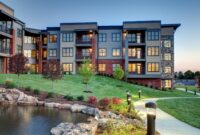Destinations Senior Living sets the stage for a comprehensive exploration of this burgeoning field. This guide delves into the diverse types of senior living options available, examining the amenities, services, and geographic considerations that influence resident choice. We’ll explore effective marketing strategies, financial aspects, and the crucial role of community building in creating fulfilling and enriching environments for seniors.
From independent living to memory care, we will analyze the various models, comparing costs, services, and the overall experience they offer. Understanding the nuances of each type of senior living destination is crucial for making informed decisions, and this guide aims to provide the necessary clarity and insight.
Defining Senior Living Destinations
Senior living destinations represent a significant shift in how retirement living is approached. They are more than just places to reside; they are comprehensive communities designed to meet the evolving needs of older adults, offering a range of services and amenities within a supportive and engaging environment. This differs significantly from simply moving to a retirement community or remaining in a family home.
Senior living destinations are distinguished from other retirement options by their focus on providing a holistic lifestyle. They emphasize social interaction, health and wellness programs, convenience, and access to specialized care, all tailored to meet the specific needs of residents as they age. This contrasts with traditional retirement options, which may offer limited services or require residents to arrange for care independently.
Types of Senior Living Destinations and Their Services
Senior living destinations encompass a variety of options, each designed to cater to different levels of care and independence. Common types include independent living, assisted living, and memory care. These differ primarily in the level of support and medical assistance provided.
Amenities and Services Offered at Senior Living Destinations
A wide array of amenities and services is typically offered to enhance the residents’ quality of life. These can include: restaurant-style dining, housekeeping and laundry services, transportation assistance, scheduled social and recreational activities (such as fitness classes, arts and crafts, and outings), wellness programs (including fitness centers and health monitoring), on-site healthcare services (ranging from basic nursing care to specialized medical attention), 24-hour security and emergency response systems, and beautifully landscaped grounds and common areas for relaxation and socialization. The specific offerings vary depending on the type of facility and its target market.
Comparison of Senior Living Destination Types
| Type of Senior Living | Level of Care | Typical Amenities | Cost Range (USD/Month – Approximate) |
|---|---|---|---|
| Independent Living | Residents live independently in their own apartments or homes, with access to support services as needed. | Private apartments, common areas, dining options, transportation, social activities, housekeeping (optional). | $2,000 – $6,000+ |
| Assisted Living | Provides assistance with daily living activities such as bathing, dressing, and medication management. | Private or semi-private rooms, assistance with personal care, medication management, meals, social activities, some healthcare services. | $4,000 – $8,000+ |
| Memory Care | Specialized care for residents with Alzheimer’s disease or other forms of dementia. | Secure environment, specialized staff, personalized care plans, memory-enhancing activities, 24-hour supervision. | $6,000 – $10,000+ |
Amenities and Services at Senior Living Destinations
Senior living destinations are increasingly focusing on providing a vibrant and enriching lifestyle for residents, moving beyond basic care to offer a wide array of amenities and services designed to promote physical, mental, and social well-being. These offerings are crucial in attracting residents and contributing to a high quality of life within the community. The key is to create an environment that feels less like a healthcare facility and more like a resort-style community that caters to the specific needs and interests of its residents.
Innovative and Engaging Amenities
Top-rated senior living communities are incorporating innovative amenities to enhance resident engagement and promote active lifestyles. Examples include state-of-the-art fitness centers equipped with specialized equipment for seniors, dedicated art studios with classes taught by professional instructors, and vibrant culinary programs featuring diverse dining options and cooking demonstrations. Some communities even offer on-site salons and spas, providing convenient access to personal care services. Furthermore, many communities are establishing partnerships with local businesses and organizations to offer unique experiences such as guest lectures, musical performances, and excursions. The goal is to foster a sense of community and provide opportunities for residents to pursue their hobbies and interests.
Technology Integration in Senior Living
Technology plays a significant role in enhancing the resident experience at modern senior living destinations. Many communities are adopting telehealth solutions, enabling residents to connect with healthcare providers remotely for routine check-ups and consultations. Smart home technology, such as voice-activated assistants and medication reminders, is being integrated to improve safety and independence. Interactive digital displays throughout the community provide access to information, entertainment, and communication tools. Some communities are even using virtual reality technology to offer residents immersive experiences, such as virtual travel or museum tours. The use of technology is not only about convenience; it contributes to a safer and more engaging living environment.
Healthcare Access and Integration
Access to high-quality healthcare is a critical factor for residents choosing a senior living destination. The seamless integration of healthcare services within the community is paramount. This often includes on-site medical clinics staffed by qualified professionals, easy access to visiting specialists, and partnerships with nearby hospitals. Many communities offer a range of healthcare services, including physical therapy, occupational therapy, and medication management. The aim is to provide convenient and readily available care, minimizing the need for residents to leave the community for medical appointments. This integrated approach ensures residents receive timely and appropriate care while maintaining their comfort and independence.
Essential Services Attracting Residents
A range of essential services contributes to the appeal of senior living destinations. These services are designed to simplify daily life and provide peace of mind for residents and their families.
- 24/7 Security and Support: Providing a safe and secure environment with readily available assistance.
- Transportation Services: Offering convenient transportation to medical appointments, shopping, and social events.
- Meal Services: Providing nutritious and delicious meals in a variety of settings, from formal dining to casual cafes.
- Housekeeping and Laundry Services: Offering convenient and regular housekeeping and laundry services, freeing up residents’ time.
- Social and Recreational Activities: Providing a wide array of engaging social and recreational activities to promote social interaction and well-being.
- Personalized Care Plans: Developing individualized care plans to meet the specific needs of each resident.
Financial Aspects of Senior Living Destinations
Choosing a senior living destination involves significant financial considerations. Understanding the various funding options and cost factors is crucial for making informed decisions and ensuring a comfortable and secure future. This section will explore the financial landscape of senior living, providing clarity on costs and available resources.
Financing Options for Senior Living
Several financing options are available to help cover the costs of senior living. These often include personal savings, retirement accounts (such as 401(k)s and IRAs), home equity, long-term care insurance, and government assistance programs like Medicaid and Medicare. Personal savings and retirement accounts represent the most common funding sources, but many residents leverage a combination of these resources to meet their financial needs. Home equity conversion mortgages (reverse mortgages) can provide access to funds tied up in a home, while long-term care insurance policies can significantly offset the costs of care. Government assistance programs offer support for those with limited financial resources, although eligibility requirements vary. It is advisable to consult with a financial advisor to determine the most suitable financing strategy.
Factors Influencing the Cost of Senior Living
The cost of senior living varies significantly depending on several key factors. The level of care required is a primary determinant, with independent living generally being the most affordable option, followed by assisted living, and then memory care, which is the most expensive. Location also plays a crucial role; senior living communities in affluent urban areas typically command higher prices than those in more rural settings. The amenities and services offered, such as dining options, recreational activities, and specialized healthcare services, also contribute to the overall cost. The size and type of accommodation, whether it’s a private room or a shared room, also influence the monthly fee. Finally, the reputation and quality of the community itself can affect pricing.
Comparison of Pricing Models in Senior Living
Senior living communities employ different pricing models. Many use a monthly fee structure that covers basic services, with additional charges for specific services or amenities. Some communities offer all-inclusive packages, where a single monthly fee covers a comprehensive range of services, while others use a tiered pricing system based on the level of care required. A few communities might incorporate a refundable entrance fee in addition to monthly fees, providing a financial stake in the community. Understanding the nuances of these models is crucial for comparing costs effectively and selecting a community that aligns with your financial capabilities.
Average Costs of Senior Living by Care Level
The following table provides a general overview of average costs. These figures are estimates and can vary significantly based on location, community amenities, and the specific needs of the resident. It is essential to contact individual communities for accurate and up-to-date pricing information.
| Care Level | Monthly Average (USD) – Low End | Monthly Average (USD) – Mid-Range | Monthly Average (USD) – High End |
|---|---|---|---|
| Independent Living | $2,500 | $4,000 | $6,000+ |
| Assisted Living | $4,000 | $5,500 | $8,000+ |
| Memory Care | $6,000 | $7,500 | $10,000+ |
End of Discussion
Ultimately, choosing the right senior living destination involves careful consideration of individual needs, preferences, and financial realities. This guide has aimed to illuminate the key factors involved in this important decision, offering a balanced perspective on the various options available. By understanding the amenities, services, geographic considerations, and financial implications, prospective residents and their families can make informed choices that ensure a comfortable, fulfilling, and enriching retirement experience.



